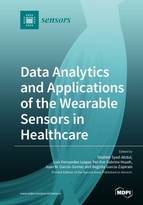Data Analytics and Applications of the Wearable Sensors in Healthcare
A special issue of Sensors (ISSN 1424-8220).
Deadline for manuscript submissions: closed (15 November 2019) | Viewed by 160027
Special Issue Editors
Interests: wearable devices; IoT in health; big data analytics; data visualization; long-term care; cancer management
Special Issues, Collections and Topics in MDPI journals
Interests: mobile health; pervasive health; social media data analytics; patient empowerment
Interests: behavioral analytics; cognitive learning and adaptation; multimdoal and text analytics; human computer interaction; consumer and pervasive health informatics
Interests: biomedical data; data analytics; data quality assessment; image analysis; companion diagnostics; predictive models; oncology; decision support systems
Interests: eHealth; biomedical engineering; computer games for health; biofeedback
Special Issues, Collections and Topics in MDPI journals
Special Issue Information
Dear Colleagues,
There is abundance of wearable devices for healthcare purposes in the market. Wearable devices aid in continuous monitoring of patients, better management of chronic diseases, reduce health care costs, prevent emergency situations, and improve care quality. The devices have a great deal of potential to generate healthcare data, with an approach to boost data analytics for research purposes [1]. However, surveys showed that 32% of users stop wearing these devices after six months, and 50% after one year. Lack of user experience and feedback, inadequate user engagement, data security and privacy concerns, are some of the reasons leading to paucity of data for research purposes, which creates hindrances in analysis [2]. This implies future concerns in the field of data analytics using wearable devices and further its application in health care.
In clinical settings, research on the devices can, not only aid patients, but also assist doctors to remotely track patients’ conditions. Use of data from the devices can help predict disease outcomes and also prevent complications, prolong lives of patients [1]. Data from wearable devices has a promising future in various healthcare domains such as oncology, geriatrics, rheumatology, cardiology, etc. Thus, it is important to generate insights on the use of these devices and awareness of the usefulness of the devices. The wide application of wearable devices in healthcare is on the rise and the immense data generated, has a huge scope and demand for research purposes. Artificial intelligence and computing technologies make use of the big data emerging as a result of use of the wearable devices [3,4]. The generated data has increasing scope in predictive analytics and improved patient care. Through this Special Issue, we aim to focus on the impediments in data collection, data analysis, application of the outcomes, and further, propose future research implications. We anticipate that this issue will develop new insights on healthcare and research applications of wearable devices and in turn aid researchers, physicians, and enhance the use of the devices among patients.
References:
[1] Gruessner, V. Key healthcare trends strengthen remote patient monitoring. 2015 [cited 2016 9 Jan 2016]; Available from: http://mhealthintelligence.com/news/key-healthcare-trends-strengthen-remote-patient-monitoring.
[2] Piwek, L., Ellis, D. A., Andrews, S., & Joinson, A. (2016). The rise of consumer health wearables: promises and barriers. PLoS Medicine, 13(2), e1001953.
[3] Priyanka, A., Parimala, M., Sudheer, K., Kaluri, R., Lakshmanna, K., & Reddy, M. P. K. (2017, November). BIG data based on healthcare analysis using IOT devices. In IOP Conference Series: Materials Science and Engineering (Vol. 263, No. 4, p. 042059). IOP Publishing.
[4] O'Dowd, E. Growth of Medical IoT Devices Supports Healthcare Analytics. 2016 [cited 2018 12 April]; Available from: https://hitinfrastructure.com/news/growth-of-medical-iot-devices-supports-healthcare-analytics.
Wearable technologies have become widely used in the health sector with applications ranging from clinical research to fitness applications. In multiple research studies wearable technologies are combined with mobile devices to collect patient reported outcomes. Furthermore, health coaching applications are widely interfacing with fitness wearable devices or smart watches.The availability of those wearable technologies are paving the wide to many disruptive data-driven applications across the whole healthcare domain. This special issue will cover a wide range of topics related to health wearable data analytics and applications such as:
- Data analytics of the wearable sensors
- Clinical applications of the wearable sensors
- Visualization of wearables health data.
- Linking digital assessment of mobility to clinical endpoints
- Actigraphy patterns
- Intrinsic variability of the actigraphy signals
- Common Representation of sensors data
- Health Recommender Systems based on Wearable Health Data.
- Sleep analysis through wearable devices
- Health Recommender Systems based on Wearable Health Data.
- Human factors, human computer interaction and usability of health wearable applications. keyword
Dr. Shabbir Syed Abdul
Dr. Luis Fernandez Luque
Dr. Pei-Yun (Sabrina) Hsueh
Dr. Juan M Garcia-Gomez
Dr. Begoña García Zapirain
Guest Editors
Manuscript Submission Information
Manuscripts should be submitted online at www.mdpi.com by registering and logging in to this website. Once you are registered, click here to go to the submission form. Manuscripts can be submitted until the deadline. All submissions that pass pre-check are peer-reviewed. Accepted papers will be published continuously in the journal (as soon as accepted) and will be listed together on the special issue website. Research articles, review articles as well as short communications are invited. For planned papers, a title and short abstract (about 100 words) can be sent to the Editorial Office for announcement on this website.
Submitted manuscripts should not have been published previously, nor be under consideration for publication elsewhere (except conference proceedings papers). All manuscripts are thoroughly refereed through a single-blind peer-review process. A guide for authors and other relevant information for submission of manuscripts is available on the Instructions for Authors page. Sensors is an international peer-reviewed open access semimonthly journal published by MDPI.
Please visit the Instructions for Authors page before submitting a manuscript. The Article Processing Charge (APC) for publication in this open access journal is 2600 CHF (Swiss Francs). Submitted papers should be well formatted and use good English. Authors may use MDPI's English editing service prior to publication or during author revisions.









